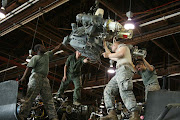Over the past year, coal has more than doubled in price. Today the use of nuclear power is a very controversial topic around the world. The cost of coal, which is primarily used in America, has drastically risen in cost. Nuclear power could create a good alternative to the negative aspects of fossil fuels for energy. Although nuclear power seems like a very scary alternative to many, nuclear power could be better for the envrioment and will create more energy for the country. Their are many environmentalists and politicians that are in support of using nuclear power. It is expected that within the next 30 years nuclear energy will be renewed (Wicks). Although nuclear power plants can stop green house gases, and give out more energy, their can be serious issues because nuclear energy is expensive, can have long term affects on people, and could potentially release large quantities of nuclear waste into the environment.
Since June of 1978 Mineral, Virginia has been receiving their power from North Anna Power Plant. North Anna Power Plant is a nuclear power facility and because a nuclear power plant must use water to function, the plant sits on the bay of Lake Anna. The plant currently has two reactors, and it is being considered to add a third reactor. The plant has caused the temperature in Lake Anna to raise, and by adding a third reactor the temperature of the lake will increase. Many of the residents of Mineral can argue that by building the third reactor they will risk lowering the lake level, and cause the lake to be to warm to enjoy. (Garber). The North Anna Power Plant can prove that America can successfully manage a nuclear power plant. But there is always a price to pay whether it is natural sources or feeling safe.
Over the years nuclear power has been used in other countries. For example, France receives 78% of its electricity from nuclear power plants (Petit). As of right now, 85% of the United States electricity comes from fossil fuels: coal, oil, and natural gas (U.S.DOE). Fossil fuels take millions of years to form, and from relying on fossil fuels for such a long time, the source is starting to run out. Not only are they running out, the fuels are emitting greenhouse gases into the air. According to Richard Meserve who wrote “Global Warming and Nuclear Power, states “A realistic response to global warming should involve harnessing a variety of energy options: increased use of renewable energy sources, sequestration of carbon at fossil-fuel plants, enhanced efficiency in energy generation and use, and increased reliance on nuclear power.” (Meserve). The combustion of fossil fuels is also threatening species, who cannot survive in the changing climate. With all the issues that go along with fossil fuel power plants , nuclear power plants are starting to become an alternative for power in the United States. Nuclear power plants give off no green house gases, which is a major focus in drastically reducing the emissions of green house gases, and in the long run cost less for the consumer (Grunwald). But nuclear power plants are extremely expensive to build, costing anywhere from $5 billion to $12 billion (Richard). According to Kristen Shrader -Frechette “Since 1949, the U.S. government has provided about $165 billion in subsidies to nuclear energy, about $5 billion to solar and wind together, and even less to energy-efficiency programs.” (Sharder).
Nuclear power gives off less waste than fossil fuels, but the radio-active waste has to be properly stored long-term. Although their is less radio-active waste, it stays active for thousands of years, so it has to be carefully watched. Their is nuclear waste repositories which hold the waste safely underground in enclosed areas. Their are two types of waste: low level waste, and high level waste. Low level waste are objects that have been contaminated with radioactive materials. High level waste are highly radioactive materials which are byproducts of reactions that take place in nuclear power. Both of these radioactive waste have designated disposal areas in the United States. Low level waste is sent to Richland, Washington; Barnwell, South Carolina; and Clive, Utah. High level waste is sent to Yucca Mountain, Nevada. High level waste can have up to a 24,000 year half-life, and will remain radioactive even after it is placed in the disposal area. Because the radioactive waste does have a half-life, precautious measures must be put in place to prevent any accidents from happening. Yucca Mountain holds nuclear fuel rods, and solidified high-level radioactive waste, both types of waste are put in underground tunnels. According to Alan Poletti “The simplest and easiest disposal method is to incorporate the waste in glass, seal it in a stainless steal container and bury it (Poletti). Their is always the possibility of a failed disposal, which would contaminate the area and ground water. The nuclear waste sites are made mostly of concrete, and the nuclear waste is put in safe containers. But their can always be a possibility of earthquakes. Although the foundation on the nuclear waste facility would meet standards, an earthquake could have the possibility of damaging the facility.
After the attack of 9/11, it has been more worrisome that nuclear power plants will be more vulnerable to terrorist attacks. According to Tyson Slocum who wrote Nuclear Power Play, “9/11 and its aftermath placed nuclear power facilities at-risk as targets, which prompted some to begin writing nuclear's obituary.”(Slocum 1). A terrorist with large explosives has a very good chance to damage a nuclear power plant, and this could lead to thousands of people becoming exposed to radiation, this exposure could lead to cancer and death. In the event of a nuclear reactor meltdown the impact could have no affect, or have a huge affect on the people in the range of the explosion. To prevent a reactor meltdown, the power plant must be safely designed so the core can be cooled if there is any loss of coolant. (Lyman 1)
On March 28th, 1979, the Three Mile Island Unit 2 nuclear power plant outside of Middletown, Pennsylvania had a incident, when a feed water pump stopped working. The pump allowed the steam generators the ability to remove heat from the core. After that happened the reactor shut down creating so much pressure that it caused the core of the reactor to overheat. The coolant for the reactor gave confusing readings to the reactor operators. This event gave off radiation, but luckily was not enough to affect the people living nearby. This accident brought attention to what can happen if an accident happens at a nuclear power plant. American citizens had a sense of uneasiness, and it eventually led to stricter regulations.
A more recent incident that took place at the Chernobyl Nuclear Power Plant in the Ukraine on April 26th, 1986. One of the plants reactors became unstable and caused a steam explosion. The core was exposed, and large amounts of radiation were emitted in the area. It took over a week to have the reactor fully contained on May 4th. The radiation was at lethal levels, and millions of people were contaminated. About 32 people were killed at the time of the accident, and close to 500 others were immediately hospitalized. The surrounding areas were evacuated. Research showed that thyroid cancer in the surrounding areas drastically increased (McGill). According to Ann McGill “Diseases caused by immunological suppression, known locally as "Chernobyl AIDS," are almost five times as prevalent now as they were before the disaster.” (McGill) .It has been 22 years since the accident, and people in the surrounding areas are still being affected (Chernobyl.info).
Before any nuclear power plants are built today, they must undergo excessive planning and regulations by the United States Nuclear Regulatory Commission. This organization was created by congress in 1974 to ensure that people and the environment are protected from radioactive material. The U.S.NRC inspects and reviews performances of all nuclear power plants in the United States. Their goals are to have no nuclear reactor accidents, no deaths resulting from acute radiation exposure from nuclear reactors, no events at nuclear reactors resulting in significant radiation exposure, no radiological sabotages at nuclear reactors, and no events that result in releases of radioactive material from nuclear reactors causing adverse impact on the environment. Although this organization exists, there is still a possibility that dangers of nuclear power plant disasters could be catastrophic.
Nuclear power plants are a logical alternative for power, but their seems to be no completely safe way to build a nuclear power plant. If a nuclear power plant was to have a incident, soil and ground water would become contaminated. The soil would have to be removed, and the radiation would linger for years. Even after years of an incident, just being in the area a person can become exposed to radiation. By putting a nuclear power plant near a town puts civilians at risk, a coal power plant would not do this. In addition the economy today could not risk spending billions of dollars on building a nuclear power plant. This would cost the government billions of dollars that the tax payers could not afford. With the fear of terrorism attacks and nuclear reactor meltdowns, American citizens are not ready to depend on nuclear power plants to receive their power. Only time will tell whether nuclear power plants will be the next big source of energy in the United States.
Works Cited
“Chernobyl Generations .” Chernobyl.info
http://www.chernobyl.info/index.php?userhash=198039&navID=529&lID=2
“Fossil Fuels.” U.S. Department of Energy. 10 Apr. 2008
Garber, Kent. “A tough Nuclear Decision.” U.S. News and World Report. Vol. 145. Issue 10
(November 2008):44-45. Academic Search Premier. EBSCOhost.
http://search.ebscohost.com/login.aspx?direct=true&db=aph&AN=34982462&site=ehost-live
Giles, Jim. “Nuclear power: Chernobyl and the future: when the price is right.” Nature. Vol. 440. Issue 7087
(April 2006):984-986.
Grunwald, Michael. “Going Nuclear.” Time Magazine Vol. 173. Issue 1.
(January 2009): 38-39 .Academic Search Premier. EBSCOhost.
http://search.ebscohost.com/login.aspx?direct=true&db=aph&AN=35921057&site=ehost-live
Hodgson, P.E. “Nuclear Power and the Energy Crisis.” Modern Age Vol. 50. Issue 3
(Summer 2008): 238-246. Academic Search Premier. EBSCOhost.
http://search.ebscohost.com/login.aspx?direct=true&db=aph&AN=35045211&site=ehost-live
Lyman, Edwin. “Can nuclear plants be safer?” Bulletin of the Atomic Scientists Vol. 64. Issue 4
(October 2008): 34-37. Academic Search Premier. EBSCOhost.
http://search.ebscohost.com/login.aspx?direct=true&db=aph&AN=34043151&site=ehost-live
Mackenzie, Debora. “Is it time for an international nuclear fuel bank?” New Science Vol. 201. Issue 2690
(January 2009): 6-7. Academic Search Premier. EBSCOhost.
http://search.ebscohost.com/login.aspx?direct=true&db=aph&AN=36262177&site=ehost-live
McGill, Ann. “Chernobyl Disaster.” Chernobyl Disaster
(2009): 1-2. Academic Search Premier. EBSCOhost.
Meserve, Richard A. “Global Warming and Nuclear Power.” Science Vol.303. Issue 5657
(January 2004): 433-433. Academic Search Premier. EBSCOhost.
http://search.ebscohost.com/login.aspx?direct=true&db=aph&AN=12186409&site=ehost-live
“Nuclear Power vs. Other Technologies.” Georgia Power 2009
Petit, Charles. “Nuclear Power.” National Geographic. April 2006.
Poletti, Alan. “Nuclear Power Now.” Power Engineer Vol. 18. Issue 2
(April/May 2004):8-8. Academic Search Premier. EBSCOhost.
http://search.ebscohost.com/login.aspx?direct=true&db=aph&AN=13269671&site=ehost-live
Richard, Michael. “New generation of nuclear power plants more expensive than expected.” Science and Technology 14 May. 2008
Rosner, Robert. “Making nuclear energy work.” Bulletin of the Atomic Scientist. Vol. 64. Issue 1
(March/April 2008): 28-57. Academic Search Premier. EBSCOhost.
http://search.ebscohost.com/login.aspx?direct=true&db=aph&AN=32587048&site=ehost-live
Sharpe, Virginia A. “Clean.” Hastings Center Report Vol. 38. Issue 4
(Jul/Aug 2008): 16-18. Academic Search Premier. EBSCOhost.
Slocum, Tyson. “Nuclear Power Play.” Multinational Monitor Vol. 29. Issue 2
(September/October 2008): 15-18. Academic Search Premier. EBSCOhost.
http://search.ebscohost.com/login.aspx?direct=true&db=aph&AN=34319492&site=ehost-live
Sharder-Frechette, Kristin. “Five myths about nuclear energy.” America Vol. 198. Issue 20.
(June 2008): 12-16. Academic Search Premier. EBSCOhost.
http://search.ebscohost.com/login.aspx?direct=true&db=aph&AN=32625382&site=ehost-live
Talbot, David. “Nuclear Powers Up.” Technology Review Vol. 108. Issue 9 Academic Search Premier. EBSCOhost. (September 2005)
Wicks, Frank. “50 Years of Nuclear Power.” Mechanical Engineering Vol. 129. Issue 11
(November 2007):36-39. Academic Search Premier. EBSCOhost.
http://search.ebscohost.com/login.aspx?direct=true&db=aph&AN=27459914&site=ehost-live







